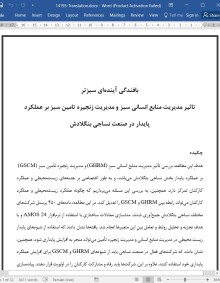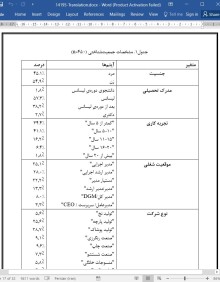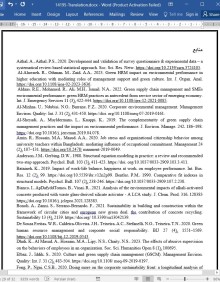
دانلود مقاله بافندگی آینده ای سبزتر: تاثیر مدیریت منابع انسانی سبز و مدیریت زنجیره تامین سبز بر عملکرد پایدار
چکیده
هدفِ این مطالعه، بررسی تأثیر مدیریت منابع انسانی سبز (GHRM)و مدیریت زنجیره تأمین سبز (GSCM) بر عملکرد پایدار بخش نساجی بنگلادش میباشد، و به طور اختصاصی بر جنبههای زیستمحیطی و عملکرد کارکنان تمرکز دارد. همچنین، به بررسی این مسئله میپردازیم که چگونه عملکرد زیستمحیطی و عملکرد کارکنان میتواند رابطه بینِ GHRM و GSCM را تعدیل کند. در این مطالعه، دادههای 450 پرسنل شرکتهای مختلف نساجیِ بنگلادش جمعآوری شدند. مدلسازی معادلات ساختاری با استفاده از نرمافزار AMOS 24 و با هدفِ تجزیه و تحلیل روابط و تعامل بینِ این متغیرها انجام شد. یافتهها نشان دادند که استفاده از شیوههای پایدار زیست محیطی در مدیریت منابع انسانی و مدیریت زنجیره تأمین میتواند منجر به افزایش پایداری شود. همچنین، نشان دادند که شرکتهای فعال در صنعت نساجی باید از شیوههای GHRM و GSCM برای افزایش عملکرد پایداری خود استفاده کنند. علاوه بر این، شرکتها باید رفاه و مشارکت کارکنان را در اولویت قرار دهند. پیادهسازی چنین استراتژی میتواند موجبِ تقویت طرحهای همهجانبه پایداری شرکت و افزایش جایگاه شرکت در بینِ ذینفعان گردد. به خاطرِ بررسی نقش میانجیگر کارکنان و عملکرد زیستمحیطی، این مطالعه میتواند سهم بزرگی در بهتر شدنِ ادبیات پژوهشی حوزهی پایداری صنعت نساجی داشته باشد، زیرا بر اهمیت استفاده از تکنیکهای GHRM و GSCM در ارتقایِ عملکرد پایدار تأکید میکند. این یافتهها میتوانند بینشهای ارزشمندی برای شرکتهای فعال در توسعه طرحهای پایداری ارائه کنند.
1. معرفی
بر اساسِ پژوهشهای موجود، بخش نساجی برای یک دورهیِ زمانی قابلتوجه سهم زیادی در اقتصاد جهانی داشته است، که باعث ایجاد چشمانداز شغلی، درآمدزایی، و تحریک توسعه اقتصادی شده است (مسعود و همکاران، 2021؛ نبی و همکاران، 2022). بااین وجود، به خاطرِ مصرف آب، انرژی، مواد شیمیایی، و درنتیجه تولید پسماندها و آلایندهها، تأثیر عمدهای بر محیط طبیعی دارد (بیانکو و همکاران، 2021؛ مسعود و همکاران، 2021). با توجه به فوریتِ مسئله جهانی "زوالِ زیستمحیطی" و ضرورت کاهش اثرات تغییرات آب و هوایی، اتخاذ روشهای پایدارتر برای بخش نساجی بسیار ضروری شده است (فنگ و نگای، 2020؛ مسعود، 2019).
بنگلادش یک کشور تولیدکننده و صادرکننده پیشرو در منسوجات نساجی است، اما منابع طبیعی، نیروی کار ماهر، و زیرساختهای آن محدود است. در این تحقیق به این پارادوکس میپردازیم تا نشان دهیم که شرکتهای برجستهی نساجی با مسائل مهم داخلی مواجه هستند. در یک مقدمه کوتاه در موردِ موفقیت و چالشهای داخلی بنگلادش، و اهمیت پژوهش صحبت میشود (هولزبرگ، 2022؛ مسعود و موندال، 2017). از آنجاییکه ترکیب شیوههای مدیریت منابع انسانی سبز (GHRM)و مدیریت زنجیره تامین سبز (GSCM) منجر به پایداری بیشتر در صنعت نساجی بنگلادش شده است، بنابراین با گنجاندنِ این شیوههای نوین، انتظار تأثیری عمیق و مثبت بر حفاظت زیستمحیطی، تعهدات اخلاقی، و تدوام دوام طولانیمدت شرکت را داریم. در این مطالعه، با هدفِ توسعهیِ صنعت نساجی آگاه به مسائل زیستمحیطی و مسئولیت اجتماعی در بنگلادش، آیندهای پایدارتر و حامیِ محیطزیست ترسیم میشود.
3.6. محدودیتها و تحقیقات آینده
در حینِ ارزیابی نتایج مطالعه باید چندین محدودیت را در نظر گرفت. 1)، یافتههای این تحقیق منحصراً مربوط به صنعت نساجی بنگلادش بود. از این رو، کاربرد آنها برای سایر بخشها یا کشورها ممکن است محدود باشد. 2) این تحقیق مبتنیبر اطلاعات خوداظهاری است که ممکن است دارایِ ایرادات ذاتی باشد. علاوه بر این، در این تحقیق، سایر متغیرهای میانجی عملکرد پایداری، مانند تحولات فناورانه یا تغییرات بازار درنظر گرفته نشدند. این یافتهها میتوانند راهگشایِ مطالعات آینده در مورد چگونگی ارتباط بینِ GHRM، GSCM و عملکرد پایداری با سایر صنایع و یا سایر کشورها باشند. انجام تحقیقات بیشتر در مورد تاثیر عامل میانجی خوشحالی و انگیزه کارمند بر سایر کیفیتها و عملکرد پایدار توصیه میشود. مسئله دیگر، استقرار و موفقیت فعالیتهای GHRM و GSCM در افزایش عملکرد پایدار با گذشت زمان است که میتواند مورد بررسی قرار گیرد. با استفاده از این یافتهها، محققان میتوانند از شیوهها و عملکرد پایدار بهرهمند شوند، و کسبوکارها نیز نسبت به محیطزیست مسئولیتپذیرتر شوند.
Abstract
The purpose of this study is to investigate the impact of Green Human Resource Management (GHRM) and Green Supply Chain Management (GSCM) on the sustainable performance of the Bangladeshi textile sector. Specifically, the study focuses on environmental and employee-related aspects. Additionally, we examine how environmental performance and employee performance mediate the relationship between GHRM and GSCM. This study draws upon data collected from 450 employees across various textile enterprises in Bangladesh. Structural Equation Modeling is employed using the Amos 24 software to analyze the relationships and interactions among these variables. These findings demonstrate that using environmentally sustainable practices in human resource management and supply chain management results in enhanced sustainability. The study indicates that environmental performance significantly influences the relationship between GHRM and GSCM regarding sustainable performance. The study findings indicate that firms operating in the textile industry should implement GHRM and GSCM practices to enhance their sustainability performance. Additionally, it is recommended that these organizations prioritize the well-being and engagement of their employees. Implementing such a strategy can bolster the organization's comprehensive sustainability initiatives and raise its standing among stakeholders. This study contributes to the expanding body of literature on textile sustainability by investigating the mediating role of employee and environmental performance. It emphasizes the significance of GHRM and GSCM techniques in improving sustainable performance. The findings provide valuable insights for firms seeking to develop more effective sustainability initiatives.
1. Introduction
Based on available research, the textile sector has significantly contributed to the worldwide economy for a considerable period. It has created job prospects, generated income, and stimulated economic expansion (Masud et al., 2021; Nabi et al., 2022). However, from the creation and consumption of water, energy, and chemicals to the creation of trash and pollutants, this sector is well recognized as having a large effect on the natural environment (Bianco et al., 2021; Masud et al., 2021). Considering the urgent worldwide issue of environmental deterioration and the need to reduce the impact of climate change, it is increasingly essential for the textile sector to adopt more sustainable methods. (Feng & Ngai, 2020; Masud, 2019).
Bangladesh is a leading textile maker and exporter, but its natural resources, skilled labour, and infrastructure are limited. This research explores this remarkable paradox, showing how a textile behemoth faces major internal issues. This brief introduction highlights Bangladesh’s success and internal challenges and sets the research’s emphasis. (Holzberg, 2022; Masud & Mondal, 2017). Integrating Green Human Resource Management (GHRM) and Green Supply Chain Management (GSCM) have great potential to promote sustainability in Bangladesh’s textile industry. By incorporating these groundbreaking methodologies, we expect a profound and positive effect on environmental conservation, ethical obligations, and the firm’s long-term viability. This study aims to facilitate the development of an environmentally conscious and socially responsible textile sector in Bangladesh, thereby promoting a more sustainable and environmentally friendly future.
6.3. Limitations and future research
Several suggestions must be considered while assessing the conclusions of the study. Initially, the research findings were exclusively relevant to the textile industry in Bangladesh; hence, their applicability to other sectors or countries may be limited. The second limitation is that the research relied on self-reported information, which might have inherent flaws. Furthermore, the research did not account for other potential mediators of sustainability performance, such as technological developments or market shifts. These findings may pave the way for future studies of how GHRM, GSCM, and sustainability performance relate to other industries and or others countries. More research into the potential mediation factor of worker happiness and motivation in the connection between other qualities and sustainability performance is necessary. The deployment and success of GHRM and GSCM activities in boosting sustainable performance over time is another something to think about. Researchers will benefit from a better knowledge of the interconnected nature of these practices and sustainability performance, and businesses will be aided in their future attempts to become more environmentally responsible as a result.
Hypothesis 01: GHRM is positively related to Sustainable Performance.
Hypothesis 02: GSCM is positively related to Sustainable Performance.
Hypothesis 03: GHRM is positively related to Environment Performance.
Hypothesis 04: GHRM is positively related to Employee Performance.
Hypothesis 05: GSCM has a positively related to Environmental Performance.
Hypothesis 06: GSCM is positively related to Employee Performance.
Hypothesis 07: Environment Performance is positively related to Sustainable Performance.
Hypothesis 08: Employee Performance is positively related to Sustainable Performance.
Hypothesis 09a: Environmental performance plays a significant role in the interplay between GHRM and sustainable performance.
Hypothesis 09b: Environmental performance has an influence on the interplay between GSCM and sustainable performance.
Hypothesis 10a: The interplay between GHRM and sustainable performance is influenced by employee performance.
Hypothesis 10b: The interplay between GSCM and sustainable performance is influenced by employee performance.
فرضیه 01: GHRM ارتباط مثبتیِ با عملکرد پایدار دارد.
فرضیه 02: GSCM ارتباط مثبتی با عملکرد پایدار دارد.
فرضیه 03: GHRM ارتباط مثبتی با عملکرد زیستمحیطی دارد.
فرضیه 04: GHRM ارتباط مثبتی با عملکرد کارکنان دارد.
فرضیه 05: GSCM رابطه مثبتی با عملکرد زیستمحیطی دارد.
فرضیه 06: GSCM ارتباط مثبتی با عملکرد کارکنان دارد.
فرضیه 07: عملکرد زیستمحیطی رابطه مثبتی با عملکرد پایدار دارد.
فرضیه 08: عملکرد کارکنان رابطه مثبتی با عملکرد پایدار دارد.
فرضیه 09 الف: عملکرد زیستمحیطی نقش معنیداری در تعامل بین GHRM و عملکرد پایدار دارد.
فرضیه 09 ب: عملکرد زیستمحیطی بر رابطهی بینِ GSCM و عملکرد پایدار تأثیر دارد.
فرضیه 10 الف: تعامل بینِ GHRM و عملکرد پایدار تحتِ تأثیر عملکرد کارکنان است.
فرضیه ۱۰ ب: رابطهیِ بین GSCM و عملکرد پایدار تحتِ تأثیر عملکرد کارکنان است.
Gender
Educational qualification
Work experience
Position
Company Type
Working department
Age of company
Employees
‘Is your company ISO 9000 certified?’
Is your company ISO 14001 certified?
Abstract
1. Introduction
2. Literature review and Hypothesis development
2.1. Underpinning theory
2.2. Hypothesis development
2.2.1. GHRM and sustainable performance
2.2.2. GSCM and sustainable performance
2.2.3. GHRM and environmental performance
2.2.4. GHRM and employee performance
2.2.5. GSCM and environmental performance
2.2.6. GSCM and employee performance
2.2.7. Environment performance and sustainable performance
2.2.8. Employee performance and sustainable performance
2.2.9. The mediating role of environmental performance and employee performance
3. Research methodology
3.1. Research design and operationalization of constructs
3.2. Tools and analysis
4. Empirical results
4.1. Survey administration and socio-demographic profile of the respondents
4.2. Common method bias test (CMB)
4.3. Descriptive statistics (EFA)
4.4. Measurement model evaluation
4.5. Reliability and validity measurements
4.6. Model fit test
4.7. Structural model analysis
4.8. Mediation analysis
4.9. Coefficient of determination (R2)
5. Discussion
6. Conclusion and implications
6.1. Theoretical implications
6.2. Practical implications
6.3. Limitations and future research
References
این محصول شامل پاورپوینت ترجمه نیز می باشد که پس از خرید قابل دانلود می باشد. پاورپوینت این مقاله حاوی 30 اسلاید و 6 فصل است. در صورت نیاز به ارائه مقاله در کنفرانس یا سمینار می توان از این فایل پاورپوینت استفاده کرد.
در این محصول، به همراه ترجمه کامل متن، یک فایل ورد ترجمه خلاصه نیز ارائه شده است. متن فارسی این مقاله در 13 صفحه (2430 کلمه) خلاصه شده و در داخل بسته قرار گرفته است.
علاوه بر ترجمه مقاله، یک فایل ورد نیز به این محصول اضافه شده است که در آن متن به صورت یک پاراگراف انگلیسی و یک پاراگراف فارسی درج شده است که باعث می شود به راحتی قادر به تشخیص ترجمه هر بخش از مقاله و مطالعه آن باشید. این فایل برای یادگیری و مطالعه همزمان متن انگلیسی و فارسی بسیار مفید می باشد.
بخش مهم دیگری از این محصول لغت نامه یا اصطلاحات تخصصی می باشد که در آن تعداد 67 عبارت و اصطلاح تخصصی استفاده شده در این مقاله در یک فایل اکسل جمع آوری شده است. در این فایل اصطلاحات انگلیسی (تک کلمه ای یا چند کلمه ای) در یک ستون و ترجمه آنها در ستون دیگر درج شده است که در صورت نیاز می توان به راحتی از این عبارات استفاده کرد.
- ترجمه فارسی مقاله با فرمت ورد (word) با قابلیت ویرایش و pdf بدون آرم سایت ای ترجمه
- پاورپوینت فارسی با فرمت pptx
- خلاصه فارسی با فرمت ورد (word)
- متن پاراگراف به پاراگراف انگلیسی و فارسی با فرمت ورد (word)
- اصطلاحات تخصصی با فرمت اکسل



